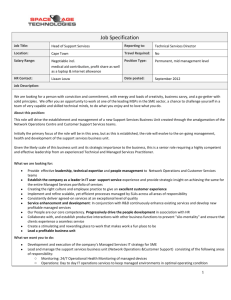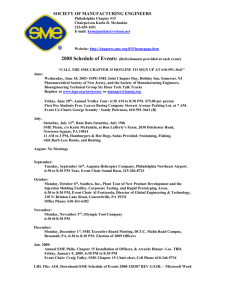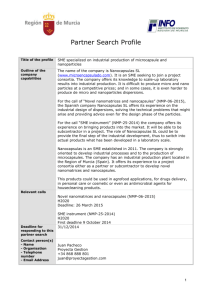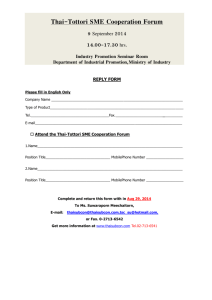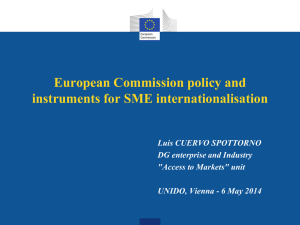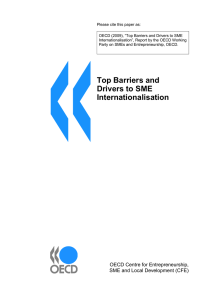uncontrollable
advertisement
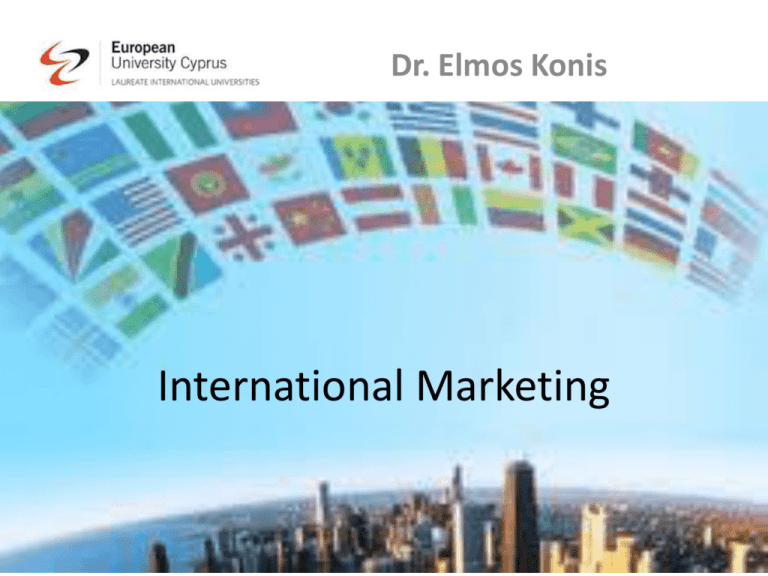
Dr. Elmos Konis International Marketing The ‘natural’ way to growth and internationalisation A ‘pie’ is made New product The ‘natural’ way to growth and internationalisation You enter this market Competitor Your share One way to Growth: You get a bigger share of this market Competitor Your share Another way to grow: The market as a WHOLE grows Competitor Your share A third way for company growth: New products Another new ‘pie’ is made A fourth way to company growth Another way to grow: Internationalisation Competitor 1 Your share Competitor 2 The three ways to view markets. Which is best for SME’s? • Aggregation Segments • Segmentation gender income family life cycle age The three ways to view markets • Customisation • And a fourth, mass customisation Which type of market should SME’s choose? • B2B (you need a specific audience to notice you) • Retail (you also need a specific audience to notice you!) • • • • • • • • What should SME’s do to go international? (The basic principles of marketing still hold true! Slide 12) Is there a need for the product abroad? Is there a niche? Do we know the TM well? (stay focused!) Who are the competitors? How powerful are they? Can there be an advantage? (e.g. personal relations) Would local collaborations be a better bet? Do we have a network? Relationship marketing! What are the difficulties (legal, political, cultural, technological) If you can’t beat them join them. Large companies cooperate with SME’s Do you have an established brand? If not, find another way. E.g… The International Marketing Mix Foreign environment (uncontrollable) 1 Political/legal forces 7 Cultural forces Domestic environment (uncontrollable) Political/ legal forces (controllable) Price Promotion 6 Geography and Infrastructure Economic forces 2 Competitive structure Competitive Forces Product Channels of distribution 7 Level of Technology Economic climate 5 4 Structure of distribution 3 Environmental uncontrollables country market A Environmental uncontrollables country market B Environmental uncontrollables country market C Consider the perception of your country in the host country Seek information and help! Get help! • E.g. 09/11/2011 - ‘Small Business, Big World — a new partnership to help SMEs seize global opportunities’ The European Commission’s new strategy aimed at helping SME’s to expand their business outside the European Union: • Strengthening and mapping the existing supply of support services • Creating a single virtual gateway to information for SMEs • Making support schemes at EU level more consistent • Promoting clusters and networks for SME internationalisation • Rationalising new activities in priority markets • Leveraging existing EU external policies How does a small firm ‘fight its war’? • Attack • Defend • Guerilla The great ‘leveller’ • The internet! (Thanks Sir Tim Berners Lee for the WWW!) Today you can be ‘born global’ and succeed even if you are small How come? • Access to and affordability of technology • The information highway • ‘Availability’ of innovation • Ease of travel • Ease of communication, building contacts Today you can be ‘born global’ and succeed even if you are small How come? • Ease of entry in some industries • Help from various sources • Fewer barriers to trade • Migration of talent • Today, people do more research before buying Inherent strengths of SME’s • • • • • Flexibility and adaptability Speed of response in developing markets Niche marketing and ‘unique’ differentiation Lower overheads Today, the ‘quirky’ exotic image sells Deciding Whether to Go Global • Reasons to consider going global: – Foreign attacks on domestic markets – Foreign markets with higher profit opportunities – Stagnant or shrinking domestic markets – Need larger customer base to achieve economies of scale – Reduce dependency on single market – Follow customers who are expanding or moving A quick look at Cyprus So, what just happened to Cyprus? It’s a Free Market We can Learn from the big boys: e.g. Demonstrate that you can think globally! (And you understand different values) BUT, Avoid the big mistakes of big companies! Honda "Fitta" is a slang rather vulgar word used in Sweden, Finland, Denmark and Norway to designate the vxxxxa. Later, the Honda "Fitta" was renamed "Honda Jazz" In most Spanish-speaking countries, we associate "Pajero" with "pajear" which is the vulgar version of "mxxxxxxxxe". It was renamed "Mitsubishi Montero" In Portuguese-speaking countries, "Pinto" means "pxxxs“. It speaks for itself! ‘Fly in leather’: "Vuela en cuero," which means simply "Fly naked" Kekoukela" which means in some dialects "Mare stuffed with wax" or even "Toad stuffed with wax" . Characters changed to Kokoukole" or "Kekoukele" which means "Happiness in the mouth" The traditional "Finger lickin 'good“, in Chinese, the slogan became: "We will cut your fingers" or "Eat your fingers" Puff in English slang is ‘gay’ Hhm… No comment So, there is room for SME’s too! Convergence or divergence? The importance of language SLEPT Industrial Structure • Shapes a country’s product and service needs, income levels, and employment levels. Subsistence Economies Raw Material Exporting Economies Industrializing Economies Industrial Economies Political-Legal Environment Attitudes Toward International Buying Government Bureaucracy Political Stability Monetary Regulations Cultural Environment • Sellers must examine the ways consumers in different countries think about and use products before planning a marketing program. • Business norms vary from country to country. • Companies that understand cultural nuances can use them to advantage when positioning products internationally. Cultural Differences When Nike learned that this stylized “Air” logo resembled “Allah” in Arabic script, it apologized and pulled the shoes from distribution. Looking at the Global Marketing Environment The International Trade System: Restrictions—tariffs, quotas, embargos, exchange controls, and non-tariff trade barriers. The World Trade Organization: Helps Trade—reduces tariffs and other international trade barriers. Regional Free Trade Zones: Groups of nations organized to work toward common goals in the regulation of international trade. Summary of Major International Marketing Decisions Finally, the Importance of language
